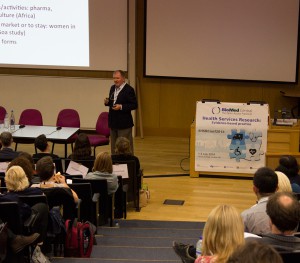 Our Health Services Research conference took place last week. Guest bloggers Jay Shaw and Anita Kothari, round up the last day and give us their thoughts on the conference overall.
Our Health Services Research conference took place last week. Guest bloggers Jay Shaw and Anita Kothari, round up the last day and give us their thoughts on the conference overall.
The final day of the conference started with two thought-provoking speakers who invoked a flurry of twitter activity.
Anne Sales, with the University of Michigan, raised the issue of social influences on implementing evidence-based practices. Such influences have a long history grounded in Rogers’ Diffusion of Innovation theory. A recent scoping review of social network studies in health (Chambers, Wilson, Thompson, Harden) found that most studies are descriptive with little emphasis on the aspects of social networks that can be attributed to patterns of diffusion.
Nevertheless, Anne reminded the audience that no single intervention across people, contexts and interventions will work – we shouldn’t expect a ‘magic bullet’ as we test different social network strategies. It might be most fruitful to first focus on understanding how social networks affect attitudes towards behaviours and social norms.
Social network analysis can also be used to support interventions by identifying opinion leaders, key groups for interventions, etc (see Tom Valente’s article in Science). This area seems ripe for further exploration, as demonstrated by a few of the presentations at the conference.
Trisha Greenhalgh then spoke about two important topics, back-to-back. The first topic was the nature of research impact and the process of evaluating impact in the UK’s Research Excellence Framework. Professor Greenhalgh described how the narrative structure of ‘impact case studies’ is crucial to demonstrating the impact of our research, and that we should put critical thought into how we want to structure those stories throughout the research process.
The second topic addressed by Professor Greenhalgh was an introduction to the campaign for ‘Real Evidence-based Medicine’ (follow on Twitter with #RealEBM). This is a way of thinking about EBM that puts the findings of clinical trials and traditional evidence-based approaches into the context of clinical encounters, recognizing the many important features of local contexts and individual needs and circumstances that help to structure clinical care. It’s time for a re-thinking of evidence-based medicine.
Henna Hasson from the Karolinska Instiutet grappled with the issues of adherence and adaptation. She presented two meta-analyses that focused on the effectiveness of program constructions (novel programs, international adoptions, contextual adoptions). Their study found that novel programs, and adapted programs, fared better than adopted, transported international programs. In other words, novel programs might represent the best fit with local context, followed by programs that are adapted to suit local conditions.
The Health Economics session was full of engaging talks ranging from real-life examples of dilemmas related to conducting (Werner Brouwer) or applying (Jeffrey Hoch) economic analysis to decision-making, to a detailed qualitative study exploring the meaning of resource allocation for cancer drugs by clinicians and patients (Charlotte Chamberlain). Very interesting food for thought!
All in all, the conference stimulated thought and discussion that brought disciplines together with the goal of improving health services worldwide. The questions for speakers were intriguing and insightful, and the Twitter conversations enabled the sharing of key resources related to the topics being addressed. We will both look forward to attending this conference next year!
Comments